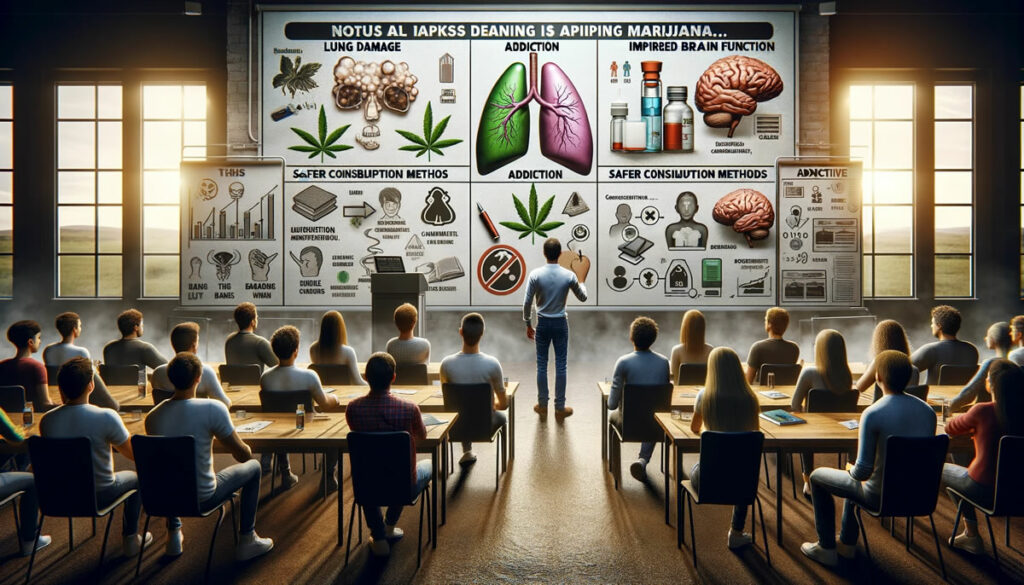As a medical professional with years of experience treating substance use disorders, I’m often asked about the safety of vaping marijuana. While some tout it as a healthier alternative to smoking, the reality is far more complex. In this article, we’ll explore the potential risks of vaping cannabis and compare it to other consumption methods.
Understanding Marijuana Vaporizers
Marijuana vaporizers, often called vape pens, are devices that heat cannabis products to a temperature high enough to create an inhalable vapor but below the point of combustion. They can be used with various forms of marijuana, including:
- Dried flower
- Oils
- Waxes
- Concentrates
Vape pens come in several varieties, from disposable models pre-filled with cannabis oil to refillable devices with adjustable temperature settings. Some are designed for use with dried flower, while others accommodate concentrates or both.
The lack of smoke and the milder smell of vapor have made vaping an increasingly popular method of marijuana consumption. However, this perceived convenience and discretion come with serious health concerns.
The Dangers of Vaping Marijuana
Despite marketing claims, vaping marijuana is not a safe practice. The Centers for Disease Control and Prevention (CDC) warns that vaping any substance can cause or worsen lung disease. When it comes to cannabis specifically, vaping may be even riskier than smoking.
EVALI: A Deadly Lung Injury
In 2019, an outbreak of severe lung illness linked to vaping swept the United States. The condition, dubbed EVALI (e-cigarette or vaping product use-associated lung injury), hospitalized over 2,500 people and claimed several dozen lives.
Investigations revealed that the majority of EVALI cases involved vaping THC, the psychoactive compound in marijuana. The culprit was identified as vitamin E acetate, an additive in some THC vape products.
However, experts believe vitamin E acetate isn’t the only dangerous ingredient in marijuana vapes. Some studies suggest that inhaling THC oil itself may irritate and damage the lungs.
Legal vs. Illegal Products
While all marijuana vaping carries risks, those dangers are magnified with illicit or counterfeit products. During the EVALI outbreak, states where recreational marijuana remained illegal saw significantly higher rates of the illness.
Even in states with legal medical or recreational cannabis, it’s crucial to purchase vape products from licensed, regulated dispensaries. These establishments should provide detailed lab reports on the contents and purity of their offerings.
Beware of unlicensed dealers or delivery services, as their products may contain harmful additives or contaminants. If a dispensary doesn’t charge sales tax or skirts other regulations, consider it a red flag.
Increased Risk of Side Effects
Vaping delivers highly concentrated doses of THC, often many times stronger than what’s found in dried marijuana flower. This potency amplifies the risk of adverse effects, both acute and long-term.
Potential side effects of marijuana use, whether vaped or consumed through other methods, include:
- Addiction
- Impaired brain function and development
- Increased risk of lung cancer
- Cardiovascular stress
- Anxiety, paranoia, and psychosis
- Depression and suicidal thoughts
Frequent, high-dose use, as is common with vaping, exacerbates these risks. THC vape oils are also associated with additional side effects like dry mouth, increased appetite, drowsiness, and nausea.
Harmful Ingredients and Byproducts
Beyond THC itself, marijuana vape products often contain an array of potentially dangerous ingredients. Due to inconsistent regulation, manufacturers aren’t always transparent about what’s in their formulas.
Some common harmful components found in vape liquids and devices include:
- Heavy metals from the heating coil
- Cancer-causing compounds formed when vape fluids are heated
- Ultrafine particles that penetrate deep into the lungs
- Toxic food flavorings like diacetyl
Even seemingly benign ingredients can combine under heat to create new, harmful chemicals. Without strict oversight and testing, it’s impossible to know exactly what you’re inhaling.
Vaping Marijuana vs. Vaping Nicotine
While neither is safe, current evidence suggests that vaping marijuana may be even more dangerous than vaping nicotine products or smoking cigarettes.
A 2021 study found that adolescents who vaped cannabis were significantly more likely to experience symptoms of lung injury compared to those who vaped nicotine or smoked either substance.
This increased risk is likely due to the high concentration of THC in vape oils, as well as the presence of vitamin E acetate and other harmful additives rarely found in nicotine vapes.
Safer Ways to Consume Marijuana
For those who choose to use marijuana, several alternative consumption methods are considered less harmful than vaping or smoking.
Edibles
Marijuana-infused foods and beverages, known as edibles, eliminate the risks associated with inhaling smoke or vapor. However, proper dosing can be challenging, as effects may not be felt for up to two hours after ingestion.
Start with a low dose and wait at least two hours before consuming more to avoid overconsumption and adverse reactions.
Tinctures and Sublingual Products
Cannabis tinctures are alcohol-based extracts that are taken sublingually (under the tongue). They offer a faster onset of effects than edibles while still avoiding the lungs.
Other sublingual options include dissolvable tablets, strips, and sprays. These products allow for more precise dosing compared to edibles but may still carry risks of intoxication and impairment.
Suppositories
For those using marijuana to treat certain medical conditions, cannabis suppositories offer a lung-safe delivery method that doesn’t produce psychoactive effects.
Rectal suppositories are sometimes used for digestive issues like irritable bowel syndrome or hemorrhoids, while vaginal suppositories may help with menstrual cramps or endometriosis pain.
Protecting Teens from Marijuana Vaping
Marijuana vaping has become alarmingly popular among American teenagers. The Drug Enforcement Agency (DEA) reports that over 13% of 12th graders vaped cannabis in 2018, a significant increase from previous years.
To combat this trend, schools and families need resources to identify vaping devices and understand their risks. Open, honest conversations about the dangers of marijuana vaping are essential to discouraging use among youth.
If you suspect your child is vaping marijuana, approach the situation with compassion and concern rather than judgment or punishment. Offer support and resources for quitting, and consider seeking professional help if needed.
The Bottom Line
As a medical expert who has witnessed the devastating effects of substance abuse firsthand, I cannot in good conscience recommend vaping marijuana as a safe practice. The risks of lung damage, addiction, impaired brain development, and exposure to harmful chemicals are simply too high.
If you choose to consume marijuana, consider safer alternatives like edibles or sublingual products. Always purchase from licensed, reputable sources and start with the lowest effective dose.
Remember, no form of marijuana use is completely risk-free. If you’re struggling with dependence or experiencing adverse effects, don’t hesitate to reach out for professional help. Your health and well-being should always come first.
- Pennsylvania Mandates Vape Product Registry for Shops - December 24, 2025
- Kyrgyzstan Imposes Six-Month Ban on E-Cigarette Imports - December 24, 2025
- US Reclassifies Marijuana to Schedule III: Key Impacts - December 22, 2025


